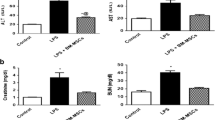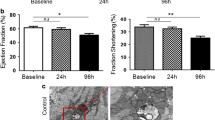Abstract
The effect of bone marrow mesenchymal stem cells (BMSCs) in treatment for multiple organ dysfunction syndrome (MODS) remains unknown and the mechanism is still unclear. Therefore, the goal of this study is to investigate the effects of intracellular high mobility group box 1 protein (HMGB1) on BMSCs treating for MODS. The rats were given 15% blood loss plus 1 mg/kg lipopolysaccharide (LPS) via lower extremity superficial venous, then randomly allocated into four groups: sham group, MODS group, MODS plus BMSC group, MODS plus ethyl pyruvate (EP) group, MODS plus BMSCs plus EP group. Twenty-four hours later, rats in groups were sacrificed and then the blood and tissues were collected to evaluate the changes of tissue histopathology, cell apoptosis, inflammation level and organ function. The HGMB1 expression was monitored by RT-qPCR and Western blot. The expression of RAGE/TLR2/TLR4 and NF-κB at the protein levels was also assessed. BMSCs and/or EP exhibits an outstanding protective effect against LPS-induced histopathological injury by improving cell apoptosis, inflammatory response and the organ dysfunction but no effect on BMSC homing to the injury site. Moreover, BMSCs and/or EP inhibited LPS-induced upregulation of HMGB1, RAGE, TLR2 and TLR4 expression at protein levels and compromised p65 phosphorylation in the rat model of MODS. These findings suggest that HMGB1 is involved in BMSC treatment for MODS, through regulation of the TLR2, TLR4-mediated NF-κB signal pathway. It suggests that HMGB1 is an attractive potential target for the development of new therapeutic strategies for MODS.






Similar content being viewed by others
References
Al-Khafaji AH, Sharma S, Eschun G (2017) Multiple organ dysfunction syndrome in sepsis. Available at https://emedicine.medscape.com/article/169640-overview
Bakhtiary Z, Shahrooz R, Ahmadi A, Soltanalinejad F (2016) Ethyl pyruvate ameliorates the damage induced by cyclophosphamide on adult mice testes. Int J Fertil Steril 10:79
Barbash IM, Chouraqui P, Baron J, Feinberg MS, Etzion S, Tessone A, Miller L, Guetta E, Zipori D, Kedes LH (2003) Systemic delivery of bone marrow-derived mesenchymal stem cells to the infarcted myocardium. Circulation 108:863–868
Brun-Buisson C (2000) The epidemiology of the systemic inflammatory response. Intensive Care Med 26:S064–S074
Chen B, Na F, Yang H, Li R, Li M, Sun X, Hu B, Huang G, Lan J, Xu H (2017) Ethyl pyruvate alleviates radiation-induced lung injury in mice. Biomed Pharmacother 92:468–478
Dong W, Cai B, Pena G, Pisarenko V, Vida G, Doucet D, Lee M, Sharpe S, Lu Q, Xu D-Z (2010) Ethyl pyruvate prevents inflammatory responses and organ damage during in porcine hemorrhage. Shock (Augusta, Ga) 34:205
Du XW, Wu HL, Zhu YF, Hu JB, Jin F, Lv RP, Sun S, Wang HY, Xu JW (2013) Experimental study of therapy of bone marrow mesenchymal stem cells or muscle-like cells/calcium alginate composite gel for the treatment of stress urinary incontinence. Neurourol Urodyn 32:281–286
El-Menyar A, Al Thani H, Zarour A, Tuma M, AbdulRahman H, Parchani A, Peralta R, Latifi R (2013) Multiple Organ Dysfunction Syndrome (MODS): is it preventable or inevitable? Int J Clin Med 3:722
Erlandsson Harris H, Andersson U (2004) Mini-review: the nuclear protein HMGB1 as a proinflammatory mediator. Eur J Immunol 34:1503–1512
Ge Y, Ezzell RM, Shaw Warren H (2000) Localization of endotoxin in the rat intestinal epithelium. J Infect Dis 182:873–881
Hayakawa K, Pham L-DD, Arai K, Lo EH (2013) High-mobility group box 1: an amplifier of stem and progenitor cell activity after stroke. Brain Edema XV. Springer:31–38
Heming Y, Maoxing Y, Jianzhong L (2000) The changes of gastric hormones in MODS rats models made of hemorrhage and endotoxin. J Traumatic Surg 2:86–88
Herzog EL, Chai L, Krause DS (2003) Plasticity of marrow-derived stem cells. Blood 102:3483–3493
Huang L-f, Yao Y-m, Sheng Z-y (2012) Novel insights for high mobility group box 1 protein-mediated cellular immune response in sepsis: a systemic review. World J Emerg Med 3:165–171
Ibrahim ZA, Armour CL, Phipps S, Sukkar MB (2013) RAGE and TLRs: relatives, friends or neighbours? Mol Immunol 56:739–744
Kallis Y, Alison MR, Forbes SJ (2007) Bone marrow stem cells and liver disease. Gut 56:716–724
Kim S-W, Lim C-M, Kim J-B, Shin J-H, Lee S, Lee M, Lee J-K (2011) Extracellular HMGB1 released by NMDA treatment confers neuronal apoptosis via RAGE-p38 MAPK/ERK signaling pathway. Neurotox Res 20:159–169
Kung C-W, Lee Y-M, Cheng P-Y, Peng Y-J, Yen M-H (2011) Ethyl pyruvate reduces acute lung injury via regulation of iNOS and HO-1 expression in endotoxemic rats. J Surg Res 167:e323–e331
Ling Bin CJ, Wang T-h, Pan X-h, Sun J, Liu P (2010a) Apoptotic protease activating factor-1 expression in the heart, liver and lung of rabbits with multiple organ dysfunction syndrome following bone marrow mesenchymal stem cells transplantation. J Clin Rehab Tissue Eng Res 14:4
Ling Bin JC, Wang T, Pan X, Sun J (2010b) Bone marrow mesenchymal stem cells transplantation down-regulates the mRNA expression of the apoptotic factor Apaf-1 in hearts, spleens, and kidneys of rabbits with MODS. J Kunming Med Univ 31:6
Manieri NA, Stappenbeck TS (2011) Mesenchymal stem cell therapy of intestinal disease: are their effects systemic or localized? Curr Opin Gastroenterol 27:119
Meng E, Guo Z, Wang H, Jin J, Wang J, Wang H, Wu C, Wang L (2008) High mobility group box 1 protein inhibits the proliferation of human mesenchymal stem cells and promotes their migration and differentiation along osteoblastic pathway. Stem Cells Dev 17:805–814
Miyaji T, Hu X, Yuen PS, Muramatsu Y, Iyer S, Hewitt SM, Star RA (2003) Ethyl pyruvate decreases sepsis-induced acute renal failure and multiple organ damage in aged mice. Kidney Int 64:1620–1631
Müller S, Ronfani L, Bianchi M (2004) Regulated expression and subcellular localization of HMGB1, a chromatin protein with a cytokine function. J Intern Med 255:332–343
Orlic D, Hill JM, Arai AE (2002) Stem cells for myocardial regeneration. Circ Res 91:1092–1102
Peng TC, Liao KW, Lai HL, Chao YFC, Chang FM, Harn H-J, Lee RP (2006) The physiological changes of cumulative hemorrhagic shock in conscious rats. J Biomed Sci 13:385–394
Raman KG, Sappington PL, Yang R, Levy RM, Prince JM, Liu S, Watkins SK, Schmidt AM, Billiar TR, Fink MP (2006) The role of RAGE in the pathogenesis of intestinal barrier dysfunction after hemorrhagic shock. Am J Physiol Gastrointest Liver Physiol 291:G556–G565
Ramirez M (2013) Multiple organ dysfunction syndrome. Curr Probl Pediatr Adolesc Health Care 43:273–277
Reis LA, Borges FT, Simoes MJ, Borges AA, Sinigaglia-Coimbra R, Schor N (2012) Bone marrow-derived mesenchymal stem cells repaired but did not prevent gentamicin-induced acute kidney injury through paracrine effects in rats. PLoS One 7:e44092
Sharma SK, Naidu G (2016) The role of danger-associated molecular patterns (DAMPs) in trauma and infections. J Thorac Dis 8:1406
Song Qiong LB, Sun J, Liu P (2009) Treatment of multiple organ dysfunction syndrome by administration of mesenchymal stem cells. Int J Surg 36:3
Wakitani S, Okabe T, Horibe S, Mitsuoka T, Saito M, Koyama T, Nawata M, Tensho K, Kato H, Uematsu K (2011) Safety of autologous bone marrow-derived mesenchymal stem cell transplantation for cartilage repair in 41 patients with 45 joints followed for up to 11 years and 5 months. J Tissue Eng Regen Med 5:146–150
Yang H, Wang H, Chavan SS, Andersson U (2015) High mobility group box protein 1 (HMGB1): the prototypical endogenous danger molecule. Mol Med 21:S6
Yang R, Zhu S, Tonnessen TI (2016) Ethyl pyruvate is a novel anti-inflammatory agent to treat multiple inflammatory organ injuries. J Inflamm 13:37
Funding
This work was supported by the Natural Science Foundation of China (81360289) and the Applied Basic Research of Yunnan Province (Associated Special Program of Kunming Medical University) (2012FB076, 2015FB079, 2017FE468(1180)).
Author information
Authors and Affiliations
Corresponding author
Ethics declarations
Rat care was in full compliance with the Guide for the Care and Use of Laboratory Animals and the use of laboratory animals in the research and all studies were approved by the Animal Ethical Committee of Kunming Medical University.
Conflict of interest
The authors declare that they have no conflicts of interest.
Electronic supplementary material

ESM 1
The identify of biomarkers in BMSCs Expression of CD90 + CD34 (B), CD44 + CD45 (C), and control by cultured cells was evaluated by flow cytometric analysis using anti-CD34, anti-CD44, anti-CD45, and anti-CD90 antibodies. Control isotype antibody is plotted in (A). Cultured cells were confirmed as BM-MSCs by their appearance in culture and by the CD44+CD90+CD34-CD45- phenotype (JPEG 72.3 kb)

ESM 2
The beneficial effects of BMSCs on MODS treatment Different organ morphological changes in intestine (A and B), liver (C), kidney (D), lung (E), and spleen (F) of SD rats 24 hours after LPS-administration (1mg/kg i.v.) (40× magnification). (G) Histopathological analysis of the heart, lung, intestine, liver and kidney. M, MODS; N, Normal (JPEG 233 kb)

ESM 3
BMSCs homed to damaged tissues Immunofluorescence staining of the heart (A), liver (B), spleen (C), lung (D), kidney (E), intestine (F), brain (G) and quadriceps (H) of SD rats 3 days after BMSCs transplantation. (JPEG 219 kb)
Rights and permissions
About this article
Cite this article
Xiu, G., Sun, J., Li, X. et al. The role of HMGB1 in BMSC transplantation for treating MODS in rats. Cell Tissue Res 373, 395–406 (2018). https://doi.org/10.1007/s00441-018-2823-0
Received:
Accepted:
Published:
Issue Date:
DOI: https://doi.org/10.1007/s00441-018-2823-0




